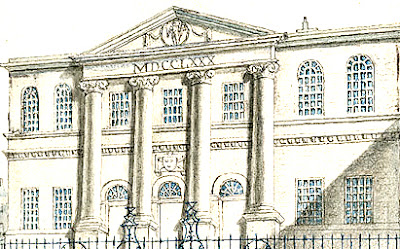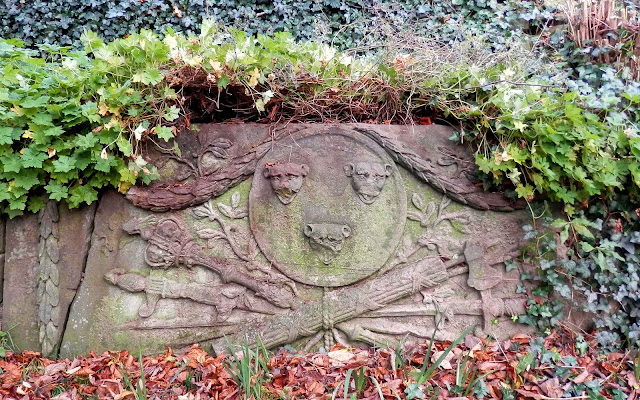According to the book 'Public Sculpture of Worcestershire & Shropshire', the piece of decorative work in our photo is “a coat of arms showing three leopards, swags and foliage, which surmounts a collection of crossed swords, maces and fasces” (all are symbols of authority).
However, the story of this particular loggerheads set is not properly known.
 |
| Shrewsbury Guildhall 1796 by Ingelby, detail (from Wikimedia Commons) |
The Abbey Gardens were originally the site of the stoneyard of John Carline The Elder (1730-95) who was both an architect and a sculptor. He seems to have been a collector of pieces discarded from demolished buildings as well as a maker in his own right.
So, are these loggerheads a piece he found? Or a piece he made, only for it never to be used?
The gardens, though small, are worth a quick visit. Among the old Guildhall stonework lying about in the gardens, is the head of Justice, and some old Ionic column capitals.
To comment on this post, just use the Comments field down this page.
To get an email alert into your inbox every time we make a new post (about once a week), just put your email address into the Follow By Email Box (in the column to the right on this page) and hit Submit






Hmm! Well, I think I could be persuaded that the sculpture could in fact be connected to the old Shrewsbury Guildhall. Take the crossed swords and three leopards from above the Guildhall doorway in the picture and add the swags from above the central top window and you're almost there. No?
ReplyDeleteMg
I have looked for better images of Haycock’s Shirehall to no avail, including a fine drawing by Buckler in the early 1820s. But Buckler, normally so detailed, only offers a scribble where the arms are!
ReplyDeleteI am inclined to agree with your contributor who suggests the arrangement at the Abbey Gardens might be an amalgam of bits. Another thought; did the arms change with a changing monarch? If so, could the ones at the Abbey Gardens represent a different coat of arms from that in your image (which comes from Wikipedia/Nat. Museum of Wales)?
PS